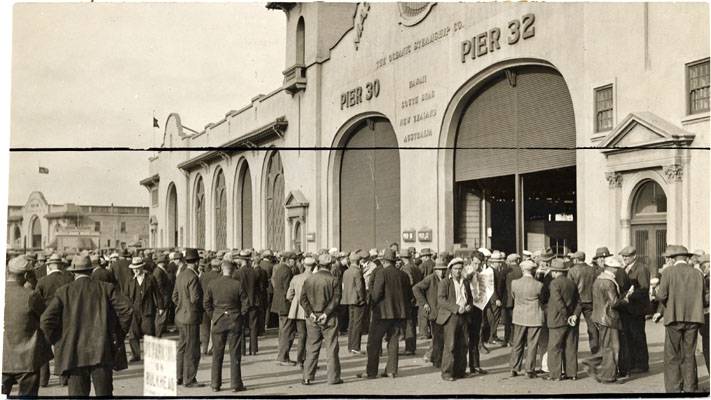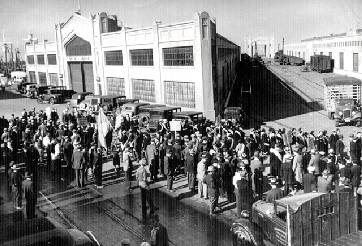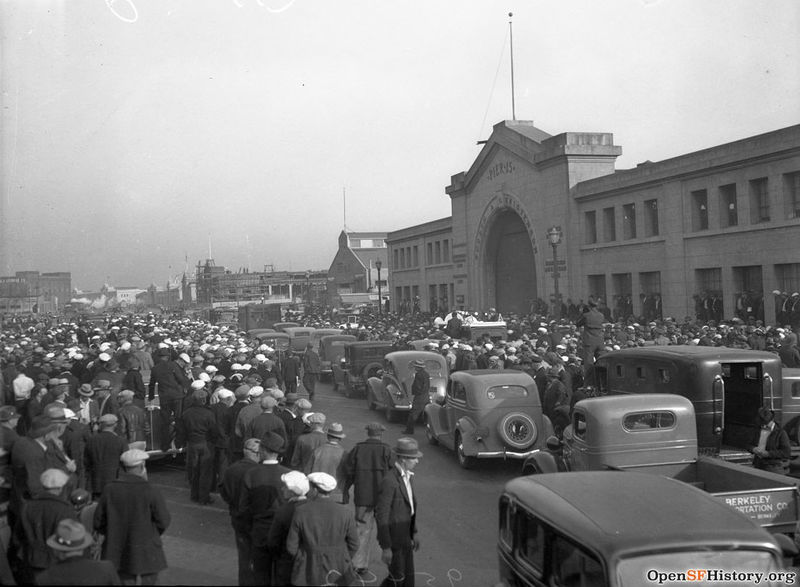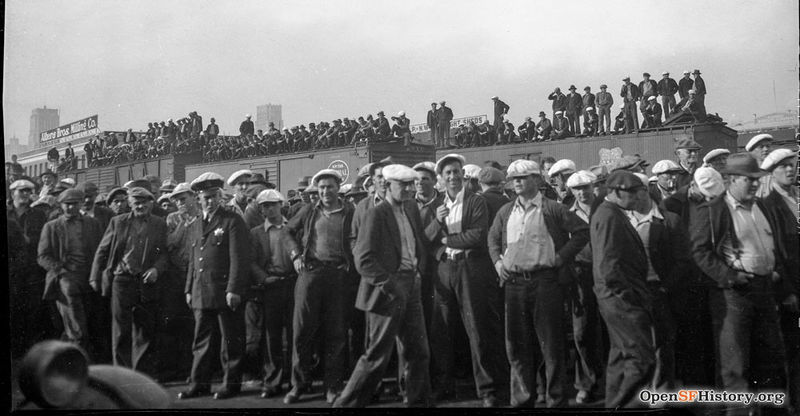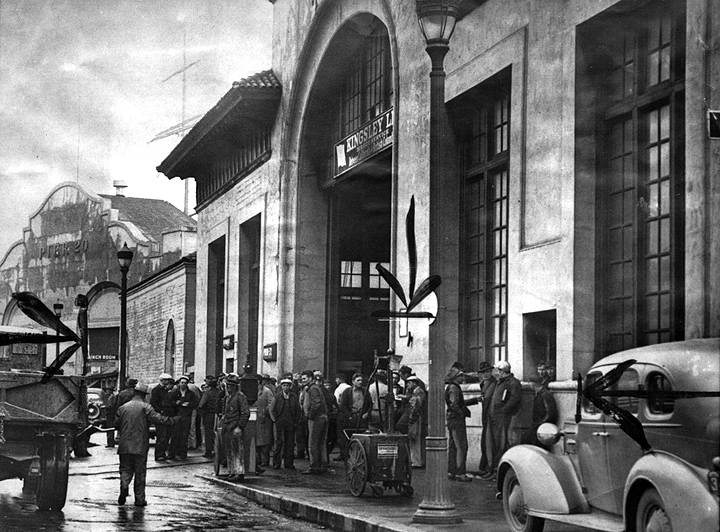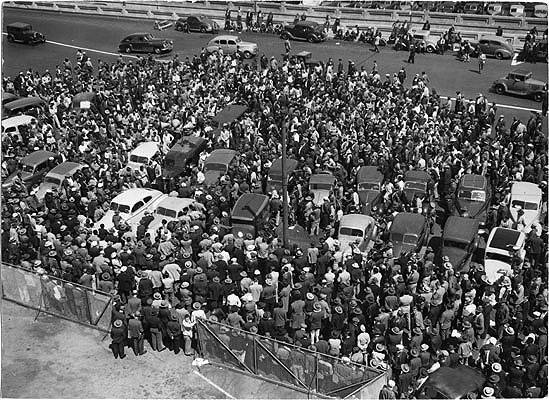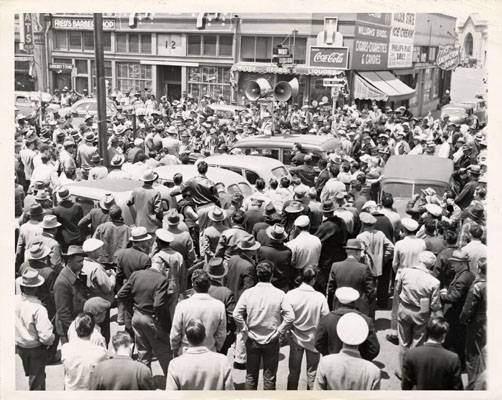A Community That Fights: Difference between revisions
(added video) |
(added photos) |
||
| (3 intermediate revisions by 2 users not shown) | |||
| Line 21: | Line 21: | ||
''Photo: San Francisco History Center, San Francisco Public Library'' | ''Photo: San Francisco History Center, San Francisco Public Library'' | ||
[[Image:Longshoremen-crowd-the-Embarcadero-at-Pier-15-Sep-27-1937 wnp14.jpg|800px]] | |||
'''Sept. 27, 1937, longshoremen crowd the Embarcadero at Pier 15 during a job action.''' | |||
''Photo: OpenSFHistory.org'' | |||
[[Image:Longshoremen-near-Pier-15-Sep-27-1937 wnp14.jpg|800px]] | |||
'''Sept. 27, 1937.''' | |||
''Photo: OpenSFHistory.org'' | |||
| Line 27: | Line 39: | ||
There were three distinct, yet frequently interrelated components to this militancy: (1) the enforcement of the contract, (2) an insistence upon safety, and (3) an insistence that the work proceed sensibly. Broadly speaking, an effective militancy could be exercised by the men simply because their employer was fundamentally dependent upon their initiative and good will. . . Because of the experience, skills and innovative talent which he brought to the job, the good longshoreman could routinely exercise a very effective job control when in his judgement that seemed necessary. . . The men upon whom the employer could most readily rely for a really first class stevedoring job and a very conscientious performance of the work were men who were viewed by their fellow workers as the very best of union men and the most militant of their union brothers. | There were three distinct, yet frequently interrelated components to this militancy: (1) the enforcement of the contract, (2) an insistence upon safety, and (3) an insistence that the work proceed sensibly. Broadly speaking, an effective militancy could be exercised by the men simply because their employer was fundamentally dependent upon their initiative and good will. . . Because of the experience, skills and innovative talent which he brought to the job, the good longshoreman could routinely exercise a very effective job control when in his judgement that seemed necessary. . . The men upon whom the employer could most readily rely for a really first class stevedoring job and a very conscientious performance of the work were men who were viewed by their fellow workers as the very best of union men and the most militant of their union brothers. | ||
[[Image: | [[Image:Longshore-wildcat-against-no-smoking-rule-pier-22-1943.jpg]] | ||
'''Quick job-action against new "no smoking" policy, 1943. ''' | '''Quick job-action against new "no smoking" policy, 1943. ''' | ||
| Line 37: | Line 49: | ||
[[Image:Sept-1945-maritime-workers-mass-meeting-on-waterfront-to-discuss-strike-AAD-5542.jpg]] | [[Image:Sept-1945-maritime-workers-mass-meeting-on-waterfront-to-discuss-strike-AAD-5542.jpg]] | ||
'''Maritime workers publicly mass to discuss a strike in September | '''Maritime workers publicly mass to discuss a strike in September 1946.''' | ||
''Photo: San Francisco History Center, San Francisco Public Library'' | ''Photo: San Francisco History Center, San Francisco Public Library'' | ||
| Line 47: | Line 59: | ||
''Photo: San Francisco History Center, San Francisco Public Library'' | ''Photo: San Francisco History Center, San Francisco Public Library'' | ||
<iframe src="https://archive.org/embed/LongshoremenAtWork" width="640" height="480" frameborder="0" webkitallowfullscreen="true" mozallowfullscreen="true" allowfullscreen></iframe> | |||
'''This film spans the twenty-five years of ILWU longshore history in San Francisco and Oakland from 1969 to 1994. Its images and sounds recount a dramatic story of change in our working lives, our industry, and our port.''' First produced in 1979, it was shown at poetry readings presented by Waterfront Writers and Artists. Now transferred to DVD, this work of art stands as both a memorial to our colorful past and a tribute to our work and our union with one another. | |||
''This film was filmed and composed by: Brian Nelson, ILWU Ship Clerk Local 34, retired; Frank Silva, ILWU Ship Clerk Local 34, retired; Michael Vawter, ILWU Longshore Local 10, active.'' | |||
Latest revision as of 14:18, 27 May 2020
Historical Essay
by Herb Mills
from The San Francisco Waterfront: The Social Consequences of Industrial Modernization, Part One: The Good Old Days
1933 stevedore strike on San Francisco waterfront.
Photo: San Francisco History Center, San Francisco Public Library
<iframe src="http://archive.org/embed/HerbMillsAHighlySkilledJob" width="640" height="480" frameborder="0" webkitallowfullscreen="true" mozallowfullscreen="true" allowfullscreen></iframe>
Herb Mills on longshoring work and solidarity in the hold.
Video: Chris Carlsson and Steve Stallone
Demo against scrap metal to Japan, 1937
Photo: San Francisco History Center, San Francisco Public Library
Sept. 27, 1937, longshoremen crowd the Embarcadero at Pier 15 during a job action.
Photo: OpenSFHistory.org
Sept. 27, 1937.
Photo: OpenSFHistory.org
By the late 1930s, San Francisco longshoremen could walk the Embarcadero and work the docks and ships with a very considerable dignity. The most concrete expression of that dignity. . . was a quite extraordinary on-the-job militancy.
There were three distinct, yet frequently interrelated components to this militancy: (1) the enforcement of the contract, (2) an insistence upon safety, and (3) an insistence that the work proceed sensibly. Broadly speaking, an effective militancy could be exercised by the men simply because their employer was fundamentally dependent upon their initiative and good will. . . Because of the experience, skills and innovative talent which he brought to the job, the good longshoreman could routinely exercise a very effective job control when in his judgement that seemed necessary. . . The men upon whom the employer could most readily rely for a really first class stevedoring job and a very conscientious performance of the work were men who were viewed by their fellow workers as the very best of union men and the most militant of their union brothers.
Quick job-action against new "no smoking" policy, 1943.
Photo: San Francisco History Center, San Francisco Public Library
The ability and willingness to undertake disciplined and well-planned job action, i.e., work-stoppages or mini-strikes of limited scope and short duration, became the very hallmark of the San Francisco longshoremen. . . While the men were destined to evolve a great number of ways of collectively expressing and, therefore, experiencing their community with one another, job action was for years the mass, democratic form. It was also the most direct, immediate and vibrant. As a collective expression and experience of community, job action was a veritable fountainhead of organizational lan and individual verve. By concretely reminding the men of the nature of their struggle and of the means whereby disputes and grievances might be resolved to their satisfaction, it was also destined to play a vital role in their evolution and self-education as a community. Hence, the militancy of these men was . . . the most complete expression and embodiment of their occupational satisfaction.
Maritime workers publicly mass to discuss a strike in September 1946.
Photo: San Francisco History Center, San Francisco Public Library
Waterfront workers in mass meeting June 6, 1946.
Photo: San Francisco History Center, San Francisco Public Library
<iframe src="https://archive.org/embed/LongshoremenAtWork" width="640" height="480" frameborder="0" webkitallowfullscreen="true" mozallowfullscreen="true" allowfullscreen></iframe>
This film spans the twenty-five years of ILWU longshore history in San Francisco and Oakland from 1969 to 1994. Its images and sounds recount a dramatic story of change in our working lives, our industry, and our port. First produced in 1979, it was shown at poetry readings presented by Waterfront Writers and Artists. Now transferred to DVD, this work of art stands as both a memorial to our colorful past and a tribute to our work and our union with one another.
This film was filmed and composed by: Brian Nelson, ILWU Ship Clerk Local 34, retired; Frank Silva, ILWU Ship Clerk Local 34, retired; Michael Vawter, ILWU Longshore Local 10, active.

